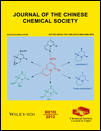Electrochemical Oxidative Detection of Guanosine-5′-triphosphate Based on a New Ionic Liquid Modified Carbon Paste Electrode
Abstract
An ionic liquid (IL) 1-(3-chloro-2-hydroxy-propyl)-3-methylimidazolium trifluoroacetate was used as the modifier for the preparation of the modified carbon paste electrode (CPE). The IL-CPE showed excellent electrocatalytic activity towards the oxidation of guanosine-5′-triphosphate (5′-GTP) in a pH 5.0 Britton-Robinson buffer solution. Due to the presence of high conductive IL on the electrode surface, the electrooxidation of 5′-GTP was greatly promoted with a single well-defined irreversible oxidation peak appeared. The electrode reaction was an adsorption-controlled process and the electrochemical parameters of 5′-GTP on IL-CPE were calculated with the electron transfer coefficient (α) as 0.44, the electron transfer number (n) as 1.99, the apparent heterogeneous electron transfer rate constant (ks) as 2.21 × 10−9 s−1 and the surface coverage (ΓT) as 1.53 × 10−10 mol cm−2. Under the selected conditions a linear calibration curve between the oxidation peak currents and 5′-GTP concentration was obtained in the range from 2.0 to 1000.0 μmol L−1 with the detection limit as 0.049 μmol L−1 (3σ) by differential pulse voltammetry. The proposed method showed good selectivity to the 5‘-GTP detection without the interferences of coexisting substances and the practical application was checked by measurements of the artificial samples.




